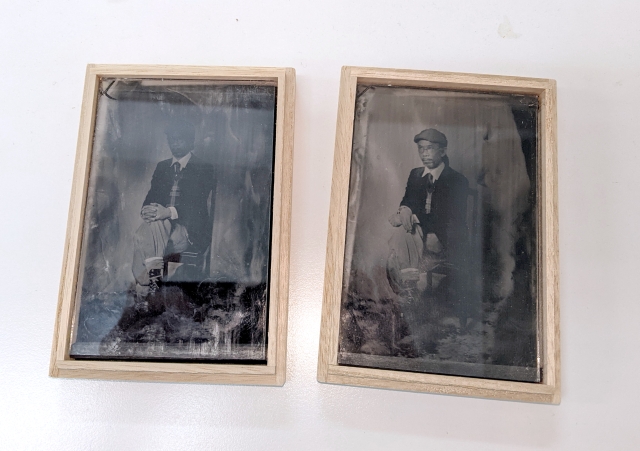
The process was slightly grueling, but the results were well worth it!
With our always-at-hand smartphones, anyone can take a picture at any moment of the day, but in the past, it wasn’t nearly so easy. One of the earliest forms of photograph technology was known as wet plate collodion photography, which captured images in a light-sensitive solution on a plate of glass or metal, rather than on film. It was a difficult and time-consuming process that required knowledge of chemistry as well as immediate access to a dark room, or your photo would not develop properly. The result was that silver-hued kind of portrait that you often see of 19th-century figures.
Did you know wet-plate photography is still used today? In fact, right now, at an event in Tokyo, you can pay to have a photo done of you that looks like it was taken 170 years ago when wet-plate photography was common. At the “Daily Life Antique Market” at the Seibu Ikebukuro department store in the Tokyo neighborhood of Ikebukuro, a booth run by the Nippori-based wet plate photography studio, Light and Place, will do it for you for just 10,000 yen (US$86.93).
Light and Place not only do wet plate photography portraits but also offer their services to period drama and theater productions as well as for magazines. At their booth at the Antique Market, you’ll get a single photo to take home, but it isn’t any old printed photo; it’s a portrait on an actual glass plate. Our own Japanese-language reporter Mr. Sato went to try it out, and the result was surprisingly cool!
But it was pretty challenging, too. Have you ever noticed that people in historical portraits always have a neutral expression? It’s because wet-plate photography takes a long time to capture an image, and it was easier to hold a relaxed pose and facial expression for the amount of time needed. At the booth, it took about six seconds for the image to be captured, and during that time, Mr. Sato couldn’t move at all.
Holding still in a stiff posture without his head or body twitching or shifting for six whole seconds was harder than it looked. You might think six seconds isn’t that bad, but when even breathing in can make your chest move, it feels like a long time. And since moving your eyes often results in turning your head, you also have to focus on a single spot, all while trying not to breathe. After doing it himself, Mr. Sato wasn’t surprised that most people opted to remain expressionless back in the day.
The process is also extremely delicate and can be affected by temperature and humidity, and since it takes about an hour to process each photo, there are challenges and risks at every step. Mr. Sato actually had to go twice to get his portrait done because the first time some trouble occurred. After this experience, Mr. Sato appreciated more than ever how easy it is to take photos these days.
Typically you only get one photo from the shoot, but because of the mishap with his first photoshoot, Mr. Sato got a second one for free. They came in these nice-looking, embossed wooden boxes. Mr. Sato wondered what waited for him inside?
Two very old-timey portraits!
As it turns out, taking pictures of a glass plate is rather hard, so Mr. Sato enlisted the help of our resident pro photographer, Tasuku Egawa. Thanks, Tasuku!
The first photo faced challenges with the lighting (which uses a specialized ultraviolet light), so it turned out a bit dark.
The second one had a much better adjustment and came out much brighter. Though he’d taken it just an hour before picking it up, it really had the feel of a portrait from the 19th century.
▼ The snappy outfit, which included glasses Mr. Sato borrowed from the studio (since normal glasses come out black in the UV lighting used), really helps add to that feeling.
To make it even more historic-looking, Mr. Sato loaded a picture of it into a photo editing program and adjusted the brightness and color. It really looks like a picture taken 150 years ago!
If you want your own Meiji-era portrait, head over to the event in the Seibu Ikebukuro department store, which is connected to the east side of Ikebukuro Station, before February 23. And if you want more cool photoshoot ideas, try transforming into an old Hollywood movie star, a Takarazuka actress, or a courtesan or a samurai!
Images © SoraNews24
● Want to hear about SoraNews24’s latest articles as soon as they’re published? Follow us on Facebook and Twitter!
[ Read in Japanese ]

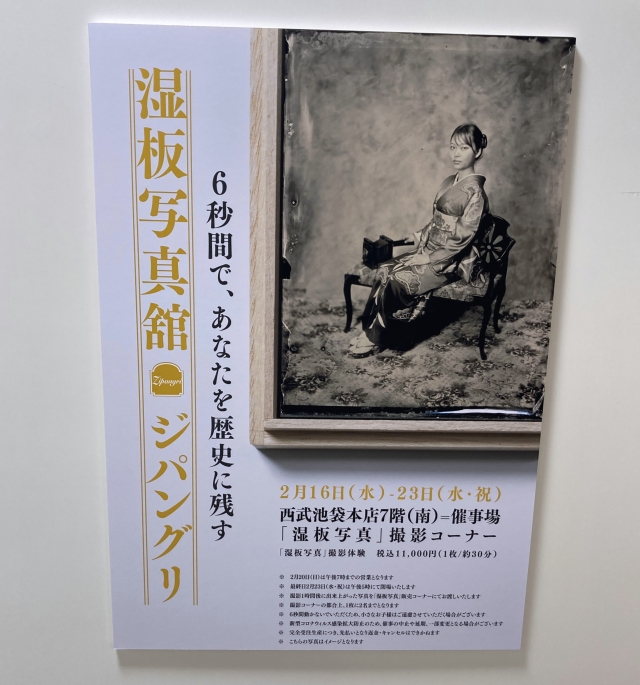
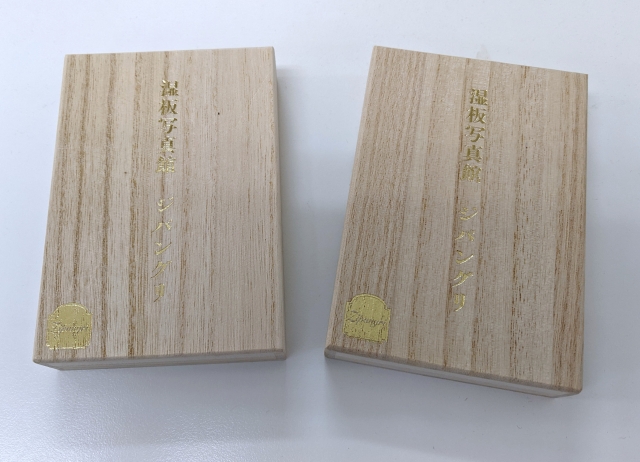
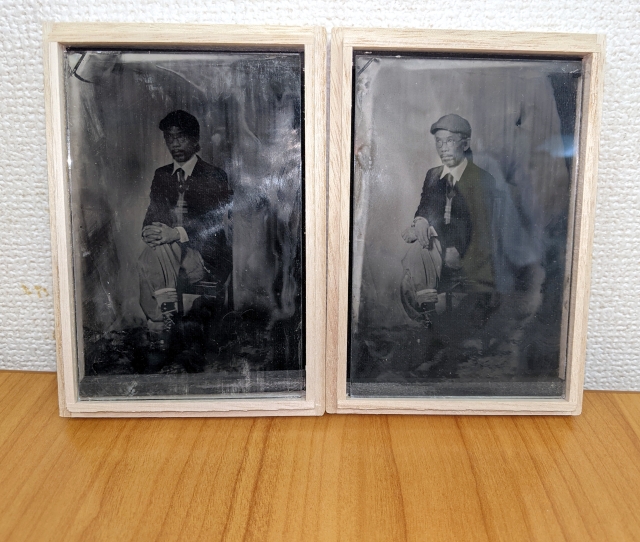

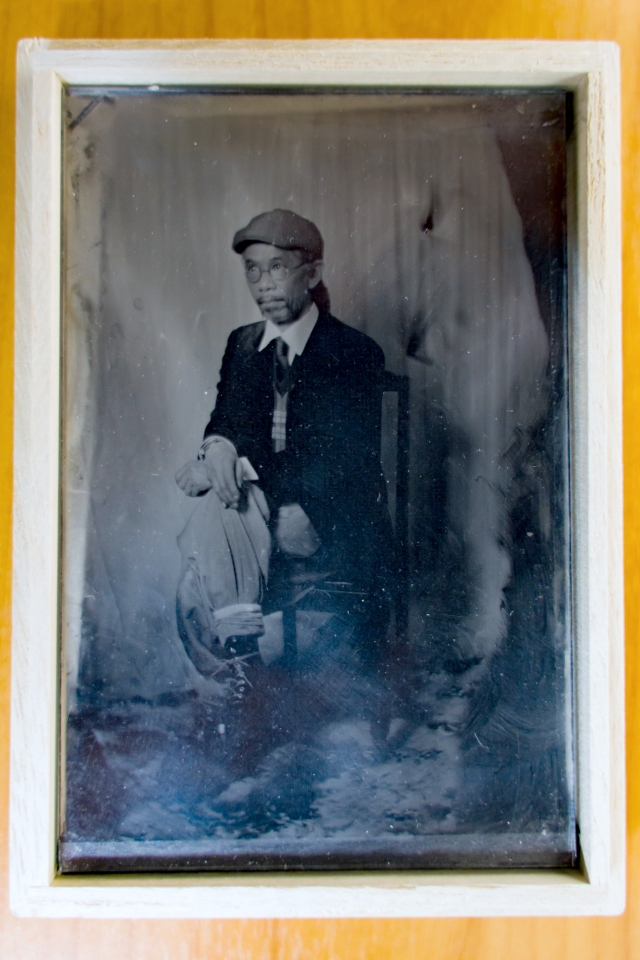
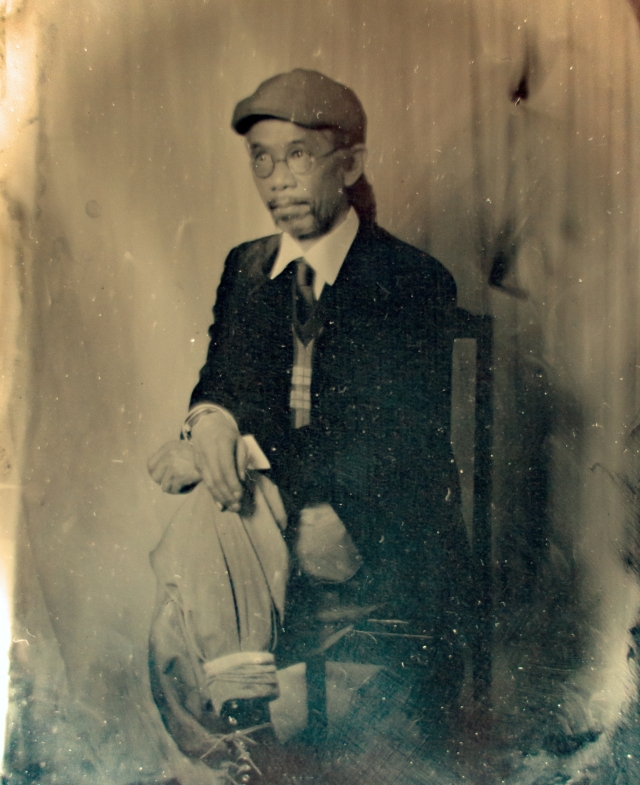
 Mr. Sato tries to make himself invisible by wearing mirror paper, creates cool modern art instead
Mr. Sato tries to make himself invisible by wearing mirror paper, creates cool modern art instead Mr. Sato broadens his home drinking horizons at Kaldi【Japan’s Best Home Senbero】
Mr. Sato broadens his home drinking horizons at Kaldi【Japan’s Best Home Senbero】 We try a Tokyo luxury hotel’s fancy Cup Noodle buffet items, eat best curry noodles of our lives
We try a Tokyo luxury hotel’s fancy Cup Noodle buffet items, eat best curry noodles of our lives Japanese chain Bikkuri Donkey’s enormous salad almost beats Mr. Sato, but not because of its size
Japanese chain Bikkuri Donkey’s enormous salad almost beats Mr. Sato, but not because of its size Beautiful booth models and tasty chow – A non-car guide to the Tokyo Motor Show【Photos】
Beautiful booth models and tasty chow – A non-car guide to the Tokyo Motor Show【Photos】 How to order snacks on a Shinkansen bullet train in Japan
How to order snacks on a Shinkansen bullet train in Japan Hello, cosmetics! Clinique teams up with Hello Kitty this summer for first-time collaboration
Hello, cosmetics! Clinique teams up with Hello Kitty this summer for first-time collaboration Demon Slayer: Kimetsu no Yaiba gets new roller coaster attractions and food at Universal Studios Japan
Demon Slayer: Kimetsu no Yaiba gets new roller coaster attractions and food at Universal Studios Japan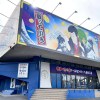 A visit to the best UFO catcher arcade in the universe!
A visit to the best UFO catcher arcade in the universe! To combat declining birth rate, Japan to begin offering “Breeding Visas” to foreigners
To combat declining birth rate, Japan to begin offering “Breeding Visas” to foreigners Spirited Away train station and submerged tracks attract Ghibli fans around Japan
Spirited Away train station and submerged tracks attract Ghibli fans around Japan Daiso DIY dessert! 100 yen store’s super-easy mochi sweets kit is our new hero
Daiso DIY dessert! 100 yen store’s super-easy mochi sweets kit is our new hero How should you respond when a Japanese person gives you a compliment?
How should you respond when a Japanese person gives you a compliment? New samurai glasses are Japan’s latest weird must-have souvenir
New samurai glasses are Japan’s latest weird must-have souvenir McDonald’s adds new watermelon frappe and fruity macaron to its menu in Japan
McDonald’s adds new watermelon frappe and fruity macaron to its menu in Japan Nintendo history you can feel – Super NES, N64, and GameCube controllers become capsule toys
Nintendo history you can feel – Super NES, N64, and GameCube controllers become capsule toys “The most Delicious Cup Noodle in history” – Japan’s French Cup Noodle wins our heart【Taste test】
“The most Delicious Cup Noodle in history” – Japan’s French Cup Noodle wins our heart【Taste test】 Starbucks releases a cute Frappuccino and Unicorn Cake…but not in Japan
Starbucks releases a cute Frappuccino and Unicorn Cake…but not in Japan Kyoto Tower mascot termination reveals dark side behind cute Japanese characters
Kyoto Tower mascot termination reveals dark side behind cute Japanese characters McDonald’s Japan’s Soft Twist Tower: A phantom ice cream only sold at select branches
McDonald’s Japan’s Soft Twist Tower: A phantom ice cream only sold at select branches Yabai Ramen: What makes this Japanese ramen so dangerous?
Yabai Ramen: What makes this Japanese ramen so dangerous? Finally! Nintendo Japan expands Switch 8-bit controller sales to everybody, Online member or not
Finally! Nintendo Japan expands Switch 8-bit controller sales to everybody, Online member or not Japanese government wants to build luxury resorts in all national parks for foreign tourists
Japanese government wants to build luxury resorts in all national parks for foreign tourists 10 things you should buy at 7-Eleven in Japan
10 things you should buy at 7-Eleven in Japan Studio Ghibli releases anime heroine cosplay dresses that are super comfy to wear
Studio Ghibli releases anime heroine cosplay dresses that are super comfy to wear Woman charged for driving suitcase without a license in Osaka
Woman charged for driving suitcase without a license in Osaka Studio Ghibli unveils My Neighbour Totoro miniature house model
Studio Ghibli unveils My Neighbour Totoro miniature house model Kyoto experiencing problems with foreign tourists not paying for bus fares, but not on purpose
Kyoto experiencing problems with foreign tourists not paying for bus fares, but not on purpose Fighting mild hunger with a Japanese soda that turns into jelly in the stomach【Taste test】
Fighting mild hunger with a Japanese soda that turns into jelly in the stomach【Taste test】 Studio Ghibli’s Howl’s Moving Castle tapestry unveiled in Japan for first time
Studio Ghibli’s Howl’s Moving Castle tapestry unveiled in Japan for first time McDonald’s new Happy Meals offer up cute and practical Sanrio lifestyle goods
McDonald’s new Happy Meals offer up cute and practical Sanrio lifestyle goods Sales of Japan’s most convenient train ticket/shopping payment cards suspended indefinitely
Sales of Japan’s most convenient train ticket/shopping payment cards suspended indefinitely Sold-out Studio Ghibli desktop humidifiers are back so Totoro can help you through the dry season
Sold-out Studio Ghibli desktop humidifiers are back so Totoro can help you through the dry season Japanese government to make first change to romanization spelling rules since the 1950s
Japanese government to make first change to romanization spelling rules since the 1950s Foreigner’s request for help in Tokyo makes us sad for the state of society
Foreigner’s request for help in Tokyo makes us sad for the state of society Ghibli founders Toshio Suzuki and Hayao Miyazaki contribute to Japanese whisky Totoro label design
Ghibli founders Toshio Suzuki and Hayao Miyazaki contribute to Japanese whisky Totoro label design Doraemon found buried at sea as scene from 1993 anime becomes real life【Photos】
Doraemon found buried at sea as scene from 1993 anime becomes real life【Photos】 Tokyo’s most famous Starbucks is closed
Tokyo’s most famous Starbucks is closed Princesses, fruits, and blacksmiths: Study reveals the 30 most unusual family names in Japan
Princesses, fruits, and blacksmiths: Study reveals the 30 most unusual family names in Japan Giant bacon cookies appear at Japan’s Guilty bakery, but do they fill us with remorse?【Taste test】
Giant bacon cookies appear at Japan’s Guilty bakery, but do they fill us with remorse?【Taste test】 Mr. Sato goes to the Tokyo Auto Salon 2022… front gate【Photos】
Mr. Sato goes to the Tokyo Auto Salon 2022… front gate【Photos】 Could you eat 50 beef cutlet refill pieces? If so, this Japanese restaurant will let you eat for free
Could you eat 50 beef cutlet refill pieces? If so, this Japanese restaurant will let you eat for free Pretty Princess Sato: Our hero gets his makeup done by a pro, brings all the boys to the yard
Pretty Princess Sato: Our hero gets his makeup done by a pro, brings all the boys to the yard Mr. Sato falls for the biggest egg sandwich he’s ever seen…but what does it look like inside?
Mr. Sato falls for the biggest egg sandwich he’s ever seen…but what does it look like inside? Mr. Sato gets invited out to dinner by seven beautiful models, struggles to speak intelligibly
Mr. Sato gets invited out to dinner by seven beautiful models, struggles to speak intelligibly One yen camera: we bought an extremely cheap camera off Yahoo! Auctions and tested it out【Pics】
One yen camera: we bought an extremely cheap camera off Yahoo! Auctions and tested it out【Pics】 What’s it like to pole dance on a rooftop in Tokyo?
What’s it like to pole dance on a rooftop in Tokyo? Mr. Sato tries to get ladies by transforming into a creepy version of L’Arc-en-Ciel’s Hyde
Mr. Sato tries to get ladies by transforming into a creepy version of L’Arc-en-Ciel’s Hyde App that buys your receipts crashes within hours of release due to too many users
App that buys your receipts crashes within hours of release due to too many users Be Mr. Sato’s online friend, and he might take you to dinner, like he did with these foreign fans
Be Mr. Sato’s online friend, and he might take you to dinner, like he did with these foreign fans Mr. Sato indulges in some trendy late-night ice cream at this specialty store
Mr. Sato indulges in some trendy late-night ice cream at this specialty store Late-night all-you-can-eat yakiniku for only 980 yen? Yes, please!
Late-night all-you-can-eat yakiniku for only 980 yen? Yes, please! One of Tokyo’s best hair salons discovered: this dank parking garage!
One of Tokyo’s best hair salons discovered: this dank parking garage! The Mr. Sato car applies to join Japan’s largest custom car event: Tokyo Auto Salon 2018
The Mr. Sato car applies to join Japan’s largest custom car event: Tokyo Auto Salon 2018 Watch as Nagoya’s famous handmade candy studio makes Mr. Sato face candies 【Video】
Watch as Nagoya’s famous handmade candy studio makes Mr. Sato face candies 【Video】
Leave a Reply